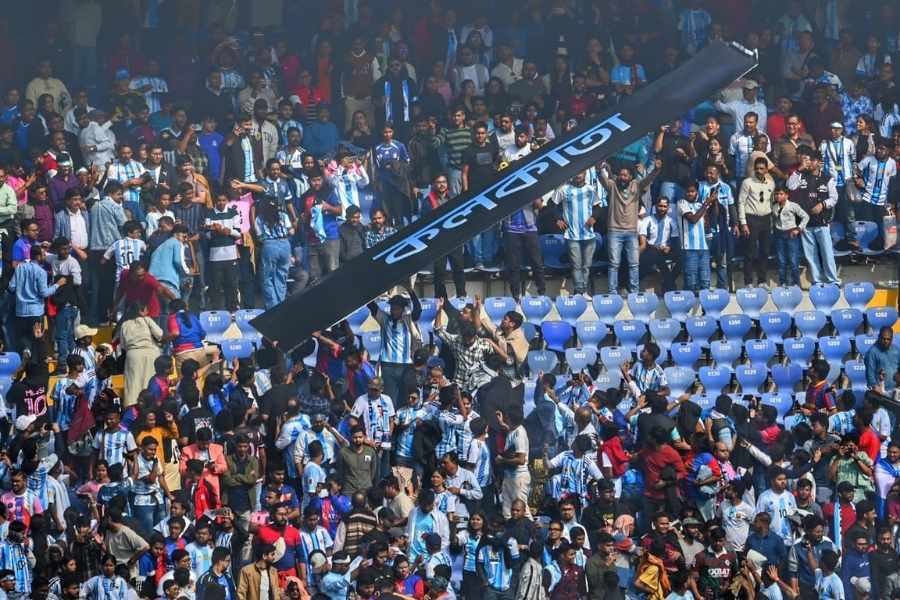 |
 |
 |
| (From top) Dev and Subhashree in the 2009 blockbuster Challenge; a scene from Clerk, considered a ‘hatke’ film; Dev during the shooting of Le Chhakka |
A film-maker from Mumbai wanted to try the Bengali market. A producer and a leading actor of Tollywood were willing to work with him. But there was a condition. The film had to be a remake, preferably of a South Indian hit. The film-maker refused and Tollywood shut its doors.
Bengali commercial cinema is getting sleeker. The heroes and heroines look almost Bollywood, thanks to a designer and stylist on board with most production teams. Songs and scenes are being shot in foreign locations — the 2009 blockbuster Challenge was shot in Dubai, Australia and New Zealand. Leading playback singers from Mumbai are being signed on. Producers have also increased their budget.
But when it comes to the script, there is no word as dirty as experimentation. It’s always a tried formula, whether from the south or from Bollywood. Though mainstream Bollywood often dazzles now with a flash of talent, as with a Kaminey or Love Sex Aur Dhokha, mainstream Tollywood remains resolutely repetitive.
“Producers say the public will not go for new stuff,” claims a former student of the Film and Television Institute of India, whose script did not meet the “required standard” in Tollywood — most often a Telugu or a Tamil hit.
The producers are not wrong; most of the remakes have meant good business: Challenge was “inspired” by a 2005 Telugu movie Bunny, Wanted — released in April this year — is “influenced” by a 2005 Telugu film Athadu while Amanush (2010) is a remake of the 2003 Tamil film Kadhal Konden. Even the very recent Le Chhakka, an “original script”, has traces of Chennai 60028 in it, says a reviewer.
Nitish Sharma had produced Clerk featuring Prosenjit earlier this year, a “hatke” film, but is eager to make a “well-packaged commercial film” the next time.
“The few parallel films that are being made do not yield good returns. So most producers and directors prefer to play it safe. And the urban audience, too, only wants a masala movie,” he claims.
The beeline for Telugu hits has to do with the packages from Andhra Pradesh that Bengali cinema cannot refuse.
Most commercial films are being shot in Ramoji Film City, on the outskirts of Hyderabad. The complex offers sets, dance and fight choreographers and junior artistes, all readily. Even the script. “A readymade script saves time and it has a higher chance of faring well,” says Mainak Biswas, a professor of film studies at Jadavpur University.
Industry insiders claim that a popular script is often purchased unofficially. Had there been no understanding between the producers, there would have been more copyright conflicts and not just an odd Poran Jai Jolia Re (a copy of Vipul Shah’s Namaste London) hitting legal trouble.
A copy works, says critic Samik Bandyopadhyay, because of the audience. The Bengali film may be looking Bollywood but the mainstay of the film is the audience in the small towns and villages, not the urban crowd.
“The bulk of the audience of a Bengali commercial movie is still the lower-middle class from the mofussils,” says Bandyopadhyay, and films from the south have all the elements that this crowd will look for. “Even the villains are usually small-time goons and not dons as shown in Bollywood. The target audience identifies with it,” he adds.
Sometimes every scene from a blockbuster is copied with the help of digital images.
This may cause Bengali cinema to look as if it is from another state, but few really mind.
“In Amanush, the physical manifestations of the protagonist’s psychological disorder were very typical of a South Indian production,” says Subhajeet Chatterjee, who also teaches film studies in Jadavpur University.
Now songs have “mahi-re” in their lyrics, actors are often found gyrating with half-clad extras of foreign origin and fight sequences show extreme violence (villains may pierce someone’s eyeballs with a toothpick). All these would once be absurd or too much; now they are necessary.
Not that anyone cares. The head of a directors’ guild in Hyderabad, Tamma Reddy Bharadwaj, claims he was not even aware of any scene-by-scene imitation from Telugu films or a financial arrangement between producers.
It is a bit like the 1980’s Bollywood, when films had snazzy disco numbers and no plots, only Mithun. But Bollywood has come out of this morass. “Mumbai has seen the accumulation of talents from all over the country for years. Since the early ’90s many film-makers have been willing to take the risk to stand out from the crowd. Besides niche marketing is possible there. Some films only cater to the urban multiplex crowd and still earn good revenue. Bollywood need not always have a small-town audience in mind,” claims Biswas.
Bengali cinema needs another Satyajit Ray, who would dare to come up with something original and bold, as Pather Panchali was, maybe shot on a hand-held camera.










